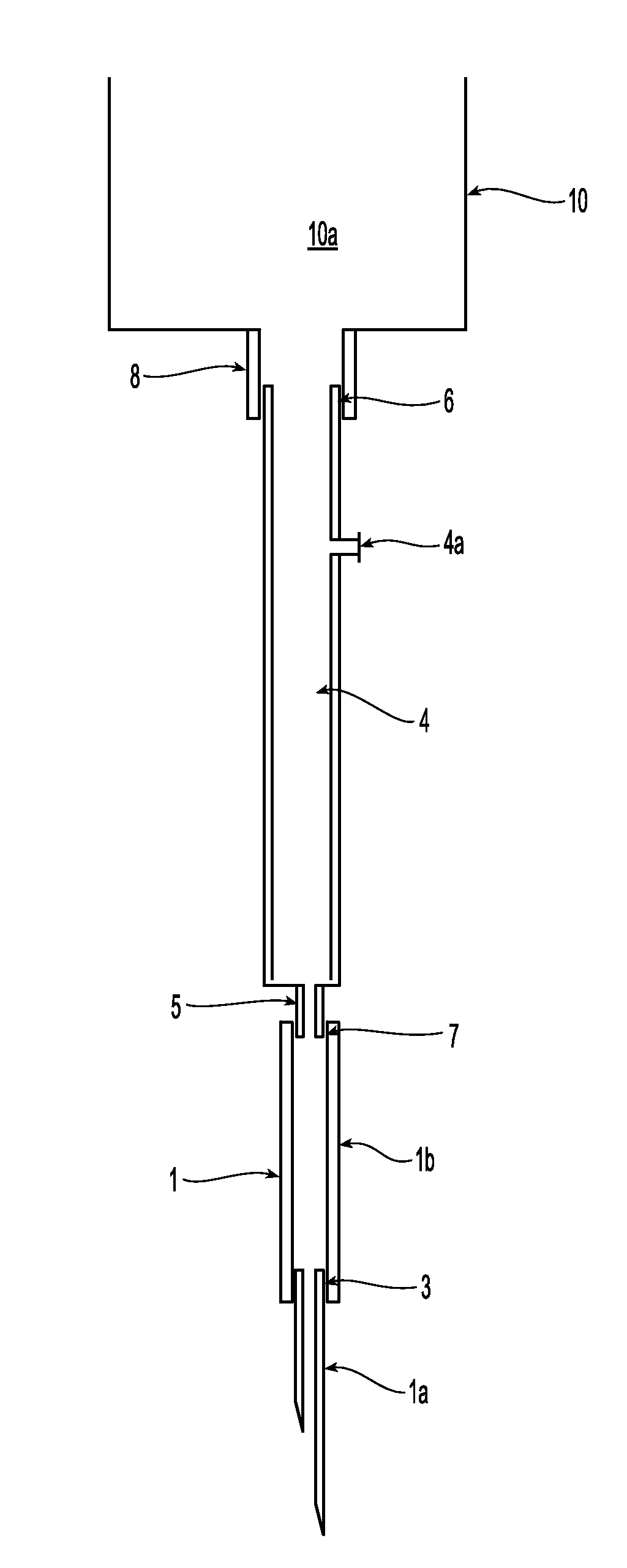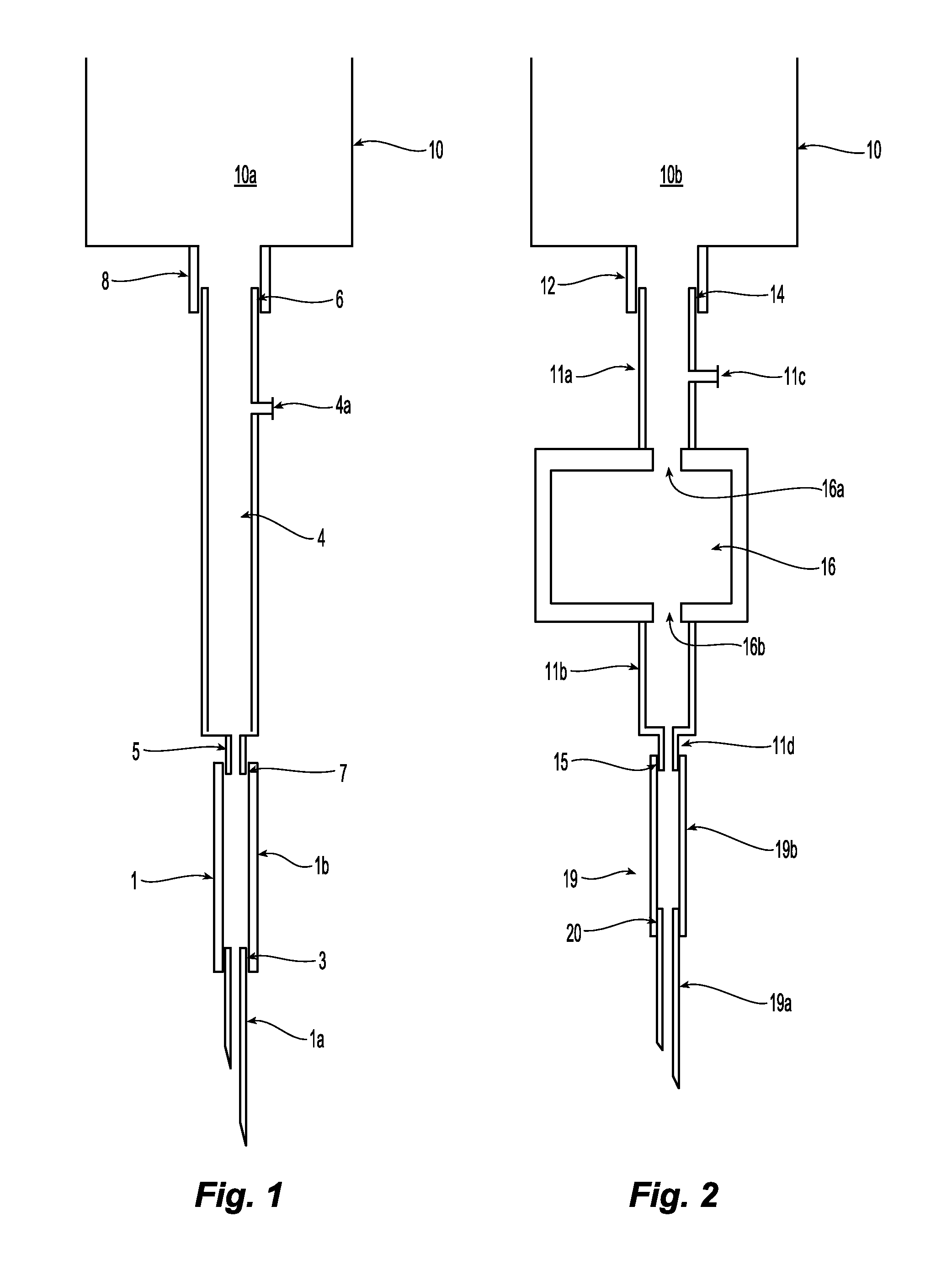The medical complications (morbidity) experienced and the cost imposed by these patients is enormous.
Blood circulates during
dialysis through some segments of the currently-used
dialysis blood circuit at extremely
high velocity and turbulence, and this causes the activation of mononuclear cells, along with the generation and release of proinflammatory cytokines and oxidants that have been identified as causing
high morbidity and mortality of
dialysis patients.
Moreover, the excessive length of the blood circuit increases the surface where circulating cells contact and are activated.
In addition, unlike the
endothelium, the circulating cells experience friction against the wall of the circuit.
The circulation of blood through dialysis catheters may be more harmful than the circulation through dialysis needles for several reasons.
The
high velocity and turbulence of the blood inside the current dialysis circuit cause activation or destruction of circulating blood cells.
The current design of the dialysis blood circuit does not fulfill the needs of hemodialysis as delivered to patients with permanent
kidney failure at present.
But, in the current dialysis circuit, blood circulates at high velocity and turbulence, is exposed to walls of the circuit that are made of materials not resembling the
endothelium of vessels, and the circuit is about 18 feet long, all of which are factors that can contribute to damage to circulating mononuclears.
Turbulent flow (and turbulent
shear stress) is more harmful than laminar flow because the velocity of the blood is higher (there is more friction) and because of the
chaotic motion of blood.
The cells inside the vortices and eddies
impact on each other or on the walls of the circuit, causing greater activation or damage to the cells.
Any increase in the
diameter of the circuit (deceleration of the flow), decreases in the
diameter of the circuit (acceleration of the flow), bends, and sharp corners cause flow separation from the wall and can be damaging to circulating cells.
The vortices of flow separation cause
chaotic movement of circulating cells and
impact of cells on the wall.
Also, there is turbulence because the
plasma would slow down before the cells in circulation and the cells up front would decelerate before the cells behind so that these cells would
impact on each other.
Likewise, bends in the circuit can cause flow separation.
Cells are damaged by the high friction caused by the high velocity and turbulence.
Also, cells coming from
fistula needle tubing 1b are damaged when they impact on the rim of the connector 5.
Impact with the rim can cause damage to many circulating cells: in one existing product, the external
diameter of the connector is 3 mm and the internal diameter is 2 mm.
That is, about 25% of the blood cells flowing through the cross-section could impact on the rim and get damaged.
In addition, circulating cells can be damaged by impacting on the rim of the
metal cannula.
Turning to FIG. 8, a rotating
blood pump 30 also can be a major cause of
high pressure, velocity and turbulence with associated activation or destruction of circulating cells.
Each time the roller progressively compresses the tube, the diameter of the tubing decreases, the velocity of the blood inside the tubing increases, and turbulence is caused by the change in internal diameter and change in velocity.
During dialysis, turbulent flow of high velocity is present inside the
vascular access in the area past the venous needle and this turbulent flow (and turbulent
shear stress) is harmful to the endothelial and circulating blood cells because the cells experience friction with each other and impact on each other or on the wall of the
vascular access causing more significant activation or destruction of cells.
Turbulent flow does not occur in normal vessels because it is an inefficient way to transfer fluids (⅓ higher consumption of energy than laminar flow), it would require much higher arterial pressure to propel blood in normal vessels, and turbulent flow, unlike laminar flow, is harmful to cells.
Therefore, much
kinetic energy is wasted in turbulent flow; if the blood flow in humans would be turbulent, higher arterial pressure would be necessary to perfuse distant organs.
There are consequences to the damage to the endothelium and the release of cytokines and oxidants of cells.
In particular, the damage to the endothelium and to circulating cells caused by the high velocity and turbulence of the flow past the venous needle during dialysis can cause or contribute to cause several complications in
dialysis patients.
The high turbulence of the flow causes endothelial damage.
Repetitive endothelial damage in the same site of the vascular access during four hours of dialysis
every other day can lead to
stenosis and
thrombosis of the vascular access.
Access complications, principally
stenosis and
thrombosis, are the major cause of morbidity of hemodialysis patients, they consume >10% of the total cost of care of all the
dialysis patients, and the occurrence of access complications is reaching epidemic proportions.
Also, failure of dialysis fistulas and grafts leads to the use of dialysis catheters that cause frequent infections, chronic
inflammation and even death.
Oxidants stimulate the release of proinflammatory cytokines and ET-1, promote adhesion of circulating cells to the endothelium and the activation of cells, and cause multiple cells dysfunctions.
Those studies demonstrated, for example, that blood circulates in some segments of the current dialysis circuit at velocities up 100 times higher than the velocity of blood in
peripheral veins, thus causing extremely high turbulence.
These lateral openings do not allow the exit of blood unless the pressure at the distal end is increased by
occlusion against the wall or clots because, as mentioned above, blood running at high velocity does not take sharp corners.
 Login to View More
Login to View More  Login to View More
Login to View More 


